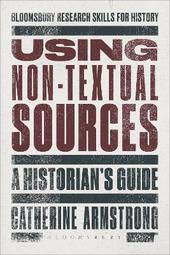
|
Using Non-Textual Sources: A Historian's Guide
Paperback / softback
Main Details
| Title |
Using Non-Textual Sources: A Historian's Guide
|
| Authors and Contributors |
By (author) Dr Catherine Armstrong
|
| Series | Bloomsbury Research Skills for History |
|---|
| Physical Properties |
| Format:Paperback / softback | | Pages:160 | | Dimensions(mm): Height 234,Width 156 |
|
| ISBN/Barcode |
9781472506535
|
| Classifications | Dewey:907.2 |
|---|
| Audience | | Tertiary Education (US: College) | |
|---|
| Illustrations |
20 bw illus
|
|
Publishing Details |
| Publisher |
Bloomsbury Publishing PLC
|
| Imprint |
Bloomsbury Academic
|
| Publication Date |
17 December 2015 |
| Publication Country |
United Kingdom
|
Description
Using Non-Textual Sources provides history students with the theoretical background and skills to interpret non-textual sources. It introduces the full range of non-textual sources used by historians and offers practical guidance on how to interpret them and incorporate them into essays and dissertations. In addition to this, the book posits a theoretical framework that justifies the use of these items as historical sources and explains how they can be used to further understand the past. There is coverage of the creation, production and distribution of non-textual sources; the acquisition of skills to 'read' these sources analytically; and the meaning, significance and reliability of these forms of evidence. Using Non-Textual Sources includes a section on interdisciplinary non-textual source work, outlining what historians borrow from disciplines such as art history, archaeology, geography and media studies, as well as a discussion of how to locate these resources online and elsewhere in order to use them in essays and dissertations. Case studies, such as the Tudor religious propaganda painting Edward VI and the Pope, the 1954 John Ford Western The Searchers and the Hereford Mappa Mundi, are employed throughout to illustrate the functions of main source types. Photographs, cartoons, maps, artwork, audio clips, film, places and artifacts are all explored in a text that provides students with a comprehensive, cohesive and practical guide to using non-textual sources.
Author Biography
Catherine Armstrong is Lecturer in American History at Loughborough University, UK. She is the author of Writing North America in the Seventeenth Century (2007) and, along with Laura M. Chmielewski, The Atlantic Experience: People, Places, Ideas (2013).
ReviewsArmstrong's work is an excellent point of entry into material for the analysis of non-textual sources. Written by an enthusiastic historian, it will be of great use to students, but can also serve as an inspiration to other researchers. * Lectures: An International Journal of Reviews in Social Sciences (Bloomsbury translation) * Students eager to find a fresh way to study history should read this book. Written in a clear, accessible style, it applies essential cultural theory to a dazzling array of examples from many continents and periods, from pottery and portraits to films and interviews. One of Catherine Armstrong's outstanding qualities as a historian is that far from talking down to her readers she encourages them to join her on an exciting and surprising voyage of historical discovery. As such, this is both a useful handbook and an extended essay, fizzing with interest and enthusiasm, that one can read with pleasure from start to finish. * Malcolm Gaskill, University of East Anglia, UK * Armstrong's Using Non-Texual Sources is an ambitious, concise, clearly structured and lucidly written introduction to the use of visual, aural, and material sources for the writing of history. Based upon a broad and deep knowledge of the relevant interdisciplinary literatures, there is no comparable textbook available for undergraduate historical methods courses. Its intended audience will find a persuasive argument for why they should look beyond textual sources as well as a detailed guide to best-practices in their analysis of film, paintings, cartoons, music, film, and artefacts. * Leora Auslander, University of Chicago, USA *
|